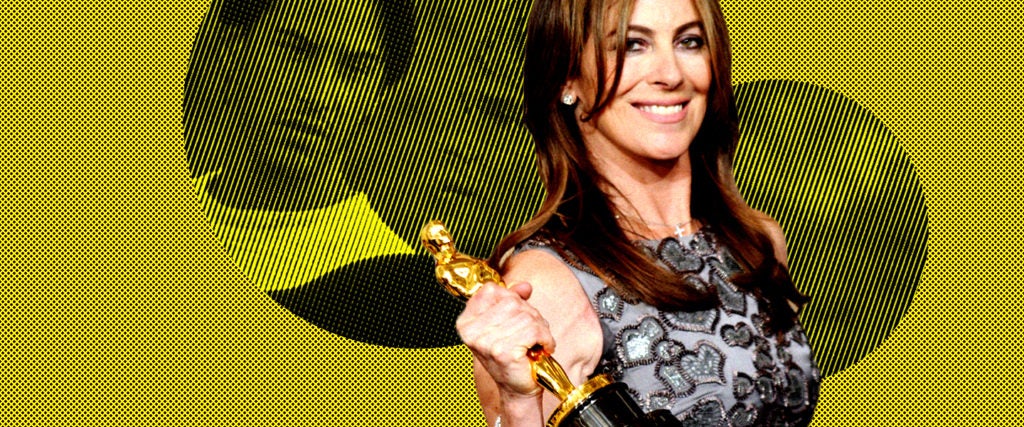Welcome to MEL’s “Women of Action” series, a week-long deep dive into five landmark action films made by female filmmakers. Far too often, writers have fixated on what women look like in the action genre — instead, I’ll be unpacking the creative influence that these five filmmakers have had behind the camera. As such, every day, I’m taking a look at one female filmmaker who has made a groundbreaking action film, as producers, auteurs, upstarts and finally, as breakthroughs, and attempting to outline their creative influence and impact on the genre, in some of the most notable (one way or the other) action films ever made.
This installment of the series was an obvious and inevitable choice: the iconic Kathryn Bigelow, a bona fide action auteur and the only woman to have won the Best Director Oscar, for her 2009 Iraq War Film The Hurt Locker. She’s a true vanguard, always pushing the boundaries of cinematic form and genre storytelling forward.
Bigelow is the one director on this list who has successfully made enough films in Hollywood without too much outside interference to be able to trace her themes, style and evolution as an auteur. There are a couple of reasons Bigelow has been able to navigate this industry and genre, which can be hostile to female interlopers. For one, she’s incredibly talented and driven. She’s also had powerful allies in the past: Oliver Stone produced her 1990 cop thriller Blue Steel, and her ex-husband James Cameron produced her surfing bank robber magnum opus Point Break, as well as her 1995 futuristic police brutality VR flick Strange Days, to which he also contributed the story (Bigelow married Cameron in 1989 shortly after his divorce from producer Gale Anne Hurd, so one could potentially argue for Hurd’s indirect influence on Bigelow’s career through him).
Bigelow has also resisted a full-throated claim of “feminist” even as she’s broken barriers, preferring instead to keep her gender out of discussions of her work. That likely makes her a bit more palatable to certain men who shied away from the “f-word,” especially in the 1990s when that term was more of a slur. Yet Bigelow has always embodied feminine power (check out the below 1988 video for Bill Paxton’s band Martini Ranch, directed by her soon-to-be husband Cameron, in which she plays a Clint Eastwood-type bounty hunter). She’s been able to infiltrate traditionally masculine movie genres while bringing her own feminine perspective to it.
Bigelow burrows into these primarily dude-oriented sub-genres and then manages to make the best version of that type of film, jumping from biker gang poetics (The Loveless), to vampire-Western mashup (Near Dark), to hyper-violent cop thriller (Blue Steel), to action sports heist movie (Point Break), to futuristic political sci-fi (Strange Days), to erotic thriller/period mystery (The Weight of Water), to Russian submarine movie (K-19: The Widowmaker), to war drama (The Hurt Locker), to CIA propaganda (Zero Dark Thirty), to historical issue film (Detroit). Genre becomes her examination tool, as she told Interview Magazine in 1989: “It’s just a matter of working within a construct that is familiar and then subverting it in order to reexamine it.” As she’s hopped from genre to genre, she’s been able to use these familiar forms to incisively observe and report on men and masculinity.
Perhaps the best loved of these is her paean to surf-soaked bromance, Point Break, a pure action film that has deservedly grown in estimation since its 1991 debut, when it ushered in a new era of 1990s action. The 1980s were a glut of well-oiled machine men and men who fought machines, à la Schwarzenegger and Stallone, but in Point Break, men were just men, in all their foibles, glory, and yes, beauty. As April Wolfe put it in Rolling Stone in 2018, Point Break “redefined the action genre with two key elements: intimacy and equality. … This is the greatest female-gaze action movie ever.” When I ask Hollywood Reporter writer and author of The Futurist: The Life and Films of James Cameron, Rebecca Keegan, for her thoughts on the movie, she puts the impact of star Keanu Reeves in Point Break thusly: “Walking out of the surf, tossing his wet hair back — it’s like her gift to us all, happy 1990s everybody, here’s a present.”
On paper, Bigelow doesn’t seem the likeliest character to take a goofy, high-concept, outlaw surfer script, cast the doofy star of Bill & Ted’s Excellent Adventure, and make a genuinely artful action movie about men and their friendships. She started as a painter, studying at the Whitney Museum under Susan Sontag and Richard Serra, while assisting conceptual video artist Vito Acconci and palling around with feminist experimental filmmaker Lizzie Borden (she makes an appearance in Borden’s 1983 militant lesbian faux-documentary Born in Flames).
But Bigelow was able to get inside the minds of Johnny Utah and Bodhi to understand what made these men tick: their egos, their rivalries, their personal credos. And she was able to do that all with a painterly yet technical execution, while minting a brand new sex symbol to boot.
Bigelow had to fight to cast Reeves as Special Agent Johnny Utah (Matthew Broderick, Johnny Depp, Charlie Sheen, Willem Dafoe and Val Kilmer were also in the running to play the upstart FBI agent). She saw something in Reeves — who had previously been in the aforementioned Bill & Ted, some TV movies, River’s Edge and Youngblood, a Canadian hockey comedy with future co-star Patrick Swayze — and what she saw was what a coterie of male producers, and her husband James Cameron, could not: Reeves is hot. Keegan put it plainly: “She got it, she saw what a generation of women would get. These movies have to appeal not just to men, there’s a whole other part of the audience watching.”
Bigelow shows her cards right away in the lyrical opening sequence of Point Break, wherein Utah nails a target practice, intercut with Bodhi getting some slow-mo tubular action. It’s an important piece of exposition, pairing these two characters together while demonstrating that Utah never misses, but Bigelow just so happens to set Utah’s target practice in the drenching rain, his soaking T-shirt clinging to his muscled torso like a wet T-shirt contest. Welcome to the 1990s, indeed.
Bigelow has impeccable taste in male beauty, which she showcases in these traditionally masculine sub-genres with a specific, yet not overt gaze. The exception to that is her 1981 directorial debut The Loveless, in which she and co-director Monty Montgomery, a Columbia pal who would go on to produce Twin Peaks, kit up new star Willem Dafoe (in his first film role after being cut out of Heaven’s Gate) in The Wild One drag, nine years before John Waters got Johnny Depp in greaser gear for Cry-Baby. They then wander the camera lasciviously over Dafoe’s leather-clad limbs in this languid meditation on the biker lifestyle and stifling 1950s gender politics.
However, Bigelow also fundamentally understands the difference between male beauty and what makes a man sexy. In Near Dark, she shoots beefcake cowboy Adrian Pasdar like a pin-up, the camera gazing lovingly on the planes of his face in the moonlight, especially during Caleb’s blood transfusion scene. But she also knows she can just let Bill Paxton loose, and secretly, all the girls will be pining for his vampire character Severen, who peacocks around with his manic, blood-smeared grin, a guy who looks like a finger-lickin’ good time. Suddenly Severen becomes the heartthrob and we start to root for the vampire gang. The same goes for sleeper hottie Clancy Brown in Blue Steel, a true respectful king, and almost a veritable cherub with those blonde curls.
Blue Steel is a fascinating antecedent to Point Break. Both films feature eager young law enforcement officers with shaggy short haircuts who become obsessed with finding their elusive targets. Blue Steel, about a female NYPD cop (Jamie Lee Curtis) battling a homicidal stockbroker stalker, is a sleaze-core thriller set in a claustrophobic cityscape and feels like a nightmare. Point Break, on the other hand, is a dream world of sandy beaches and blue swells, a ballet of water and air. It’s a fantasy world that Johnny Utah can’t resist, drawn into this free and sexy world by bank-robbing Buddha Bodhi as much as he is by surfer girl Tyler (Lori Petty).
Johnny and Tyler sport strangely similar looks, with their short black hair and lean, athletic bods (Tyler’s androgyny is underlined by her unisex, though traditionally male, first name). Bodhi manages to be universally sexy to men and women alike (seducing both Tyler and Johnny, and sometimes seducing Johnny through Tyler), with his halo of blond curls, deep tan and emphatic speeches about freedom. He’s a golden god, an enchanting Pied Piper, a surf Jesus whose message you badly want to buy. All it costs is 90 seconds of terrorizing bank patrons (and a leap off the world’s biggest wave).
It’s easy to gush about the relationship between Johnny and Bodhi and the way Bigelow, as a woman, is able to position these macho figures within this tender tableau. But it’s not all hot homoeroticism. Bigelow made significant contributions to action filmmaking in Point Break, especially with her gifted Steadicam operator, James Muro (he’s also Cameron’s favorite Steadicam op). The foot chase is one of the most thrilling pieces of action filmmaking ever made, and it holds up to this day, even if it’s fun to giggle at Johnny unloading his entire clip into the air in frustration (as parodied in Edgar Wright’s Hot Fuzz).
Everything that precedes this is breakneck breathtaking, starting with the striking image of Bodhi, in his Reagan mask and suit, turning a gas nozzle into a blowtorch and lighting up a Lincoln. (Fun fact: Stunt double Scott Wilder performed the whole foot chase — Swayze was in Europe doing press for Ghost).
Johnny takes off in hot pursuit of Bodhi and Bigelow sends Muro in hot pursuit of Johnny, equipped with a stripped-down 35mm Steadicam mounted on a gyrostabilizer called the “Pogo Cam,” which only weighed 18 pounds. With a wire loop on top, Muro could keep the actors in frame while they flung themselves over fences and sprinted through backyards. It’s all executed with an impeccable sense of geography and rhythm, while the Steadicam offers an in-your-face immediacy. It’s also used incredibly well in the robbery scenes and in John C. McGinley’s opening walk-and-talk at the L.A. FBI Bureau. Bigelow puts you on the ground and in the room with these guys so you get a sense of what it’s like to be there, and sympathize with Johnny’s plight.
As Bigelow told Gavin Smith in a 1995 Film Comment interview, “I love the purity of an unbroken shot,” and “I love that juxtaposed with the sequence that has tremendous editorial intrusion. … There are rest notes and there are flurries.” Her rhythms aren’t as mathematical as the fast-fast-slow cutting popularized by Hong Kong action films, but her musicality and flow follow the themes of the story. Stylistically and thematically juxtaposed to the heart-pounding foot chase is the soaring sky-diving sequence, another bit of breathtaking filmmaking that was ingeniously executed, both the actors and the cameras mounted on independently floating cranes. That intoxicating and adventurous sequence shows why Johnny finds it hard to resist the gravitational pull of Bodhi’s presence, as opposed to the pavement pounding pursuit.
The story of Point Break is ultimately of Bodhi’s inevitability, who through sheer will manifests his destiny on the wave of the century. Bigelow reflects that in her propulsive filmmaking, which is like a whirlpool sucking you into a vortex. As she told Smith in 1995, “the best kind of filmmaking is when it seems like it’s inevitable.”
Which, in the end, is maybe the most amazing thing about Point Break: The whole thing feels inevitable.

